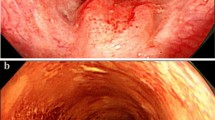Abstract: Papillary adenocarcinoma is extremely rare in the squamous epithelium-lined esophagus. The histopathologic and immunohistochemical characteristics were examined in a composite tumor showing distinct papillary adenocarcinoma and squamous cell carcinoma of the esophagus resected from a 66-year-old man. The esophageal tumor consisted both grossly and histologically of two distinct components: an ulcerative part showing a squamous cell carcinoma, and a polypoid part corresponding to a papillary adenocarcinoma. In addition, the in situ squamous cell carcinoma was contiguous with the esophageal tumor. Mucin secretion was found only in the papillary adenocarcinoma component. Immunohistochemically, tumor cells of the papillary adenocarci-noma component were positive for carcinoembryonic antigen, secretory component, and lactoferrin. These staining patterns were similar to those of the normal esophageal gland proper. These histologic, mucin-histochemical, and immunohistochemical findings suggest that the papillary adenocarcinoma originated from the submucosal esophageal gland and the squamous cell carcinoma from the squamous epithelium lining the esophagus.
Similar content being viewed by others
Author information
Authors and Affiliations
Additional information
(Received for publication on Mar. 2, 1999; accepted on Nov. 11, 1999)
Rights and permissions
About this article
Cite this article
Nakagawa, S., Nishimaki, T., Kanda, T. et al. Composite Tumor with Papillary Adenocarcinoma and Squamous Cell Carcinoma of the Esophagus: Report of a Case. Surg Today 30, 364–367 (2000). https://doi.org/10.1007/s005950050601
Issue Date:
DOI: https://doi.org/10.1007/s005950050601



